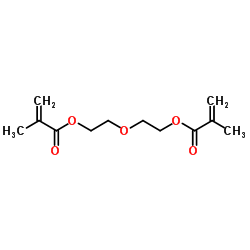Oxydi-2,1-ethanediyl bis(2-methylacrylate)

Oxydi-2,1-ethanediyl bis(2-methylacrylate) structure
|
Common Name | Oxydi-2,1-ethanediyl bis(2-methylacrylate) | ||
|---|---|---|---|---|
| CAS Number | 2358-84-1 | Molecular Weight | 242.268 | |
| Density | 1.1±0.1 g/cm3 | Boiling Point | 322.8±17.0 °C at 760 mmHg | |
| Molecular Formula | C12H18O5 | Melting Point | N/A | |
| MSDS | Chinese USA | Flash Point | 138.7±21.0 °C | |
| Symbol |

GHS07 |
Signal Word | Warning | |
|
Cytotoxicity of silica-glass fiber reinforced composites.
Dent. Mater. 24(9) , 1201-6, (2008) Silica-glass fiber reinforced polymers can be used for many kinds of dental applications. The fiber reinforcement enhances the mechanical properties of the polymers, and they have good esthetic attributes. There is good initial bonding of glass fibers to poly... |
|
|
Influence of resin monomers on growth of oral streptococci.
J. Dent. Res. 83(4) , 302-6, (2004) Ethyleneglycol dimethacrylate monomers have been previously reported to stimulate the growth of certain caries-associated bacteria on the basis of turbidity measurements. To elucidate the detail of this effect, we examined the influence of resin monomers on t... |
|
|
Photopolymerization of multilaminated poly(HEMA) hydrogels for controlled release.
J. Control. Release 57(3) , 291-300, (1999) A novel approach to immobilize nonuniform initial drug concentration profiles in multilaminated matrix devices utilizing photopolymerization techniques is presented. Solution polymerization of 2-hydroxyethyl methacrylate (HEMA) and diethylene glycol dimethacr... |
|
|
The influence of comonomer composition on dimethacrylate resin properties for dental composites.
J. Dent. Res. 75(8) , 1607-12, (1996) During the polymerization of multifunctional monomers for dental restorations, typical final double-bond conversions range from 55 to 75%. The low conversion results in a large amount of extractable monomer, reduced adhesion to the filler, and the potential f... |
|
|
Photopolymerized, multilaminated matrix devices with optimized nonuniform initial concentration profiles to control drug release.
J. Pharm. Sci. 89(1) , 45-51, (2000) This paper describes a novel approach to obtain desired release profiles from diffusion-controlled matrix devices by employing nonuniform initial concentration profiles theoretically and experimentally. Theoretically, a model was developed to examine the effe... |
|
|
Effect of drug-vinyl copolymer delivery composites on the rat prostate.
J. Biomed. Mater. Res. 19(6) , 615-29, (1985) A radiation polymerized drug-vinyl copolymer delivery composite (0.8 mm in diameter, 3 mm long) was inserted into the right-lobe ventral prostate (I), into the right testis (II), and subcutaneously (III) into the back of male Wistar rats. The implantation was... |
|
|
[Study of the pH sensitive polymer].
Guang Pu Xue Yu Guang Pu Fen Xi 26(8) , 1483-6, (2006) A pH sensitive polymer was prepared by copolymerization of methacrylic acid as monomer, diethylene glycol dimethacrylate as cross-linking reagent, heptane as porogen, and fluorescent dye eosin as indicator. The factors of influence on the preparation, and the... |